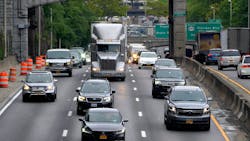New York City Launching a Study to 'Reimagine' the Cross-Bronx Expressway
New York City and New York State are launching a study to 'reimagine' the Cross Bronx Expressway which has come under fire from critics as a prime example of environmental racism.
Constructed in the 1950's and 60's by city planner Robert Moses, the expressway displaced some 40,000 residents. Since then, diesel truck traffic on the often-clogged roadway has been linked to higher air pollution nearby and some of the highest asthma rates in the country.
The “Reimagining the Cross-Bronx Expressway” study, which is Funded by a $2 million grant from the U.S. Department of Transportation (USDOT), aims to address the negative effects of the highway on nearby residents, some 220,000 residents in predominantly in Black and Latino neighborhoods.
“We are going to push back on what Robert Moses did,” Mayor Eric Adams said in a recent press conference announcing the study. “He got his way then, but he's not getting his way now.”
The first round of community meetings are set to begin in February. By 2024, the city and state will present a multiyear plan with proposals to improve neighborhood conditions around the highway.
The two-year study will identify strategies to “cap” parts of the Cross-Bronx Expressway with a deck, to prevent air pollution from seeping into nearby communities. Land above the deck could include public space, pedestrian and bike routes, and paths to reconnect neighborhoods.
The study will also identify ways to reduce vehicle emissions and unequal health outcomes in nearby communities, improve safety on local streets near the highway and “more sustainably manage” freight and other vehicle traffic, according to a city statement announcing the study.
Lifelong Bronx resident Nilka Martell, founder and director of the civic group Loving the Bronx, said the study is the culmination of her and other community members’ activism since 2016.
“We did this for free. We advocated for this for so many years,” she said, adding that she’s been in contact with staff at the Department of City Planning about the study. “To actually be here and be at the table, it’s incredible.”
Part of the federal infrastructure bill signed into law last year was promised to help fund the study. Now, the money has been officially secured through a Rebuilding American Infrastructure with Sustainability and Equity (RAISE) grant.
The study will be led by the New York City Department of Transportation and Department of City Planning, in partnership with the New York Department of Transportation (NYSDOT) and the New York City Department of Health and Mental Hygiene.
The highway also has among the highest crash and fatality rates among U.S. interstates, with an average of 159 yearly injuries on streets adjacent to the highway between 2014 and 2018, according to a statement from City Hall.
----------------------------------------------------
Source: Gothamist.com
